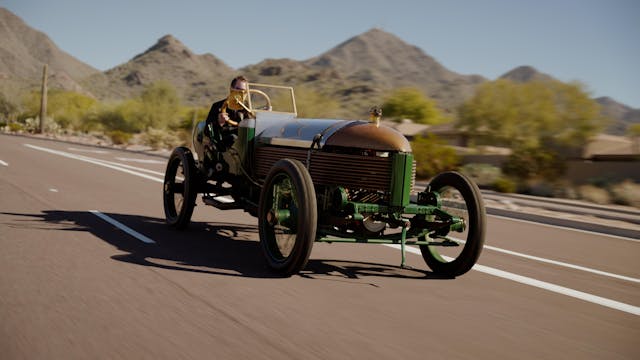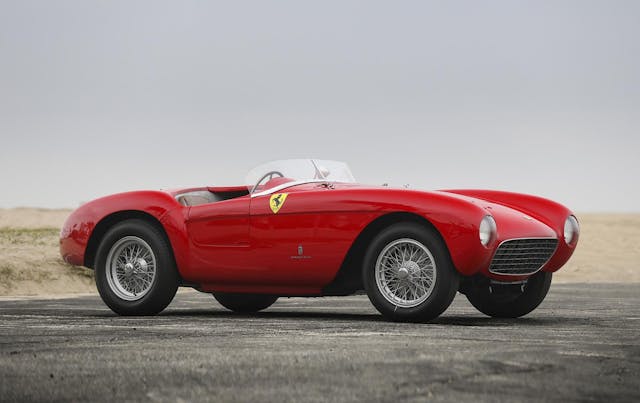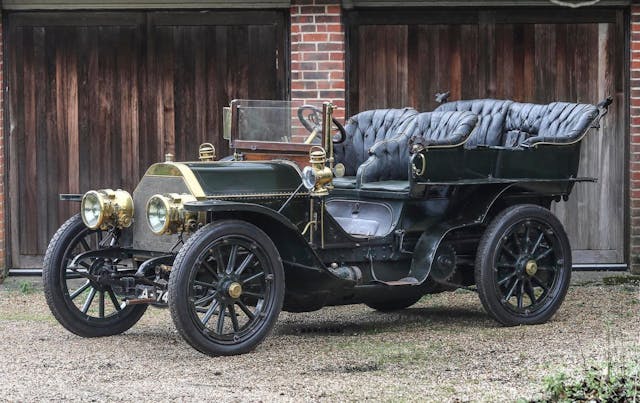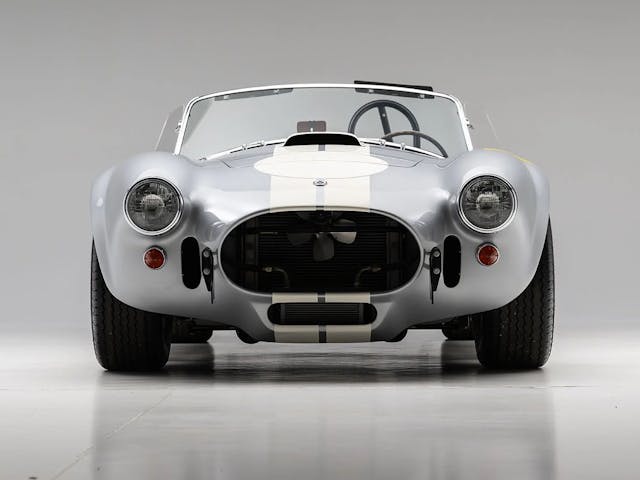These Are the Best Cars up for Grabs at Amelia Island
With the Kissimmee, Scottsdale and Rétromobile auctions behind us, next up on the event calendar is Amelia Island. Three auctions are happening, and we forecast $135M in total sales.
While Kissimmee and Scottsdale are noted for their higher volume, Amelia is a quieter series of sales with consignment lists that are shorter, but also filled with rarer, more significant and higher quality cars, along with a few oddballs thrown in. Between Gooding & Company, Bonhams and Broad Arrow, lots of noteworthy cars are crossing the block this year. Below are the cream of the crop.
1966 Shelby Cobra 427 S/C

In Cobra hierarchy, the big-block cars are naturally at the top. But not all “427” Cobras are created equal, and exact specifications can make a big difference in desirability. They range from cars powered by the higher-volume, road-oriented, police-spec 428 engine at the bottom to the full competition-spec 427 at the top.
This car is one of just 31 “Semi-Competition,” aka “S/C” Cobra 427s. After Shelby failed to secure the 427’s FIA homologation for the 1965 racing season, he was stuck with 31 intended-for-racing finished chassis, which all of a sudden had nowhere to compete. So, he made the pragmatic decision to slap on some basic road equipment and sell them to the public as one of the most outrageous street cars ever made. This one, CSX 3040, impressively retains its original body and drivetrain. It sold in Scottsdale six years ago for $2,947,500 and has a $3M-$3.75M estimate for Amelia.
1988 Porsche 959 SC by Canepa

Any Porsche 959 is special, and the 959s that have been thoroughly upgraded by Canepa in California tend to command a premium price over their factory counterparts. But this 959 also has historical significance, as it was purchased by Nissan, who famously reverse-engineered Porsche’s sophisticated variable all-wheel drive system for its revolutionary Skyline R32 GT-R.
When it went to Canepa for its upgrades in 2019, it only had about 1400 km (less than 1000 miles) on the clock. The transformation, which incudes upgrades that bump the engine to over 800 horsepower, reportedly cost $950,000, and the car has a $3.25M-$3.75M estimate in Amelia. For reference, a stock 1988 959 Komfort has a Hagerty Price Guide value ranging from $900K-$2.6M.
1931 Duesenberg Model J Disappearing Top Convertible Coupe by Murphy

The Model J is certainly in the running for best American car ever made. It’s both magnificent enough and rare enough that it’s noteworthy when any single example comes to market. Even more so when that example hasn’t come to public market or even been seen for decades. According to Gooding & Co., this 1931 Disappearing Top Convertible Coupe is “the very last example known to exist of a sporting body style that had yet to reemerge to the public eye.”
The car passed through several Chicago owners from the 1930s to early 1950s. The first was a relative of the man who founded the Culver Military Academy in Indiana, and a subsequent owner later donated the car to the very same institution in 1959, which is an odd coincidence. The academy made the car available to cadets interested in pursuing mechanical fields, but apparently no aspiring mechanic wrenched on anything too badly, because by the 1960s the Duesenberg was back in private ownership with a family in Chicago. That family placed it in their garage in 1967, and it stayed there until 2022. Brought back to running condition, it has a presale estimate of $2.75M-$3.5M.
1971 Porsche 914/6 GT

Of the roughly 119,000 Porsche 914s built from 1969-76, the vast majority had relatively humble four-cylinder VW power. But Porsche also sold a six-cylinder, 911-powered version called the 914/6 and developed it even further for racing with the 914/6 GT. To make it track- and rally-ready, Porsche added steel fender flares to accommodate wider Fuchs alloy wheels and fitted fiberglass deck lids, rocker panels, and bumpers. Antiroll bars at both ends, 911S ventilated brakes, Plexiglas rear and side windows, an extra front oil cooler, a long-range fuel tank, and competition interior completed the package.
The 914/6 GT was an accomplished car, with class wins at Le Mans and Daytona, the first three places at the Marathon de la Route at the Nürburgring, and the very first IMSA GT Championship. The car up for grabs in Amelia was part of Porsche’s three-car attack on the Monte Carlo Rally in 1971. A clutch failure took it out of the rally, which was eventually won by the little French Alpine A110, but it was later used as Vic Elford’s reconnaissance car for the Targa Florio. It has since been restored to its original Monte Carlo specs. In Amelia, it has a $1.2M-$1.5M estimate, which would put it above the $995,000 Daytona-winning car that sold in 2020 as the world’s most expensive 914.
1904 Gordon Bennet Napier L48

Powered by a 15(!)-liter F-head six-cylinder making 240 hp, this car is reportedly capable is over 100mph. With rear-only mechanical drum brakes and skinny 120-year-old wheels, that sounds terrifying, or exciting, or a little bit of both.
The car is a faithful reconstruction of the 1904 Gordon Bennett Napier L48 “Samson” racer, assembled using the original engine. And quite a power plant it is, represented as the world’s first six-cylinder racing engine. It roared past 100 mph at Daytona Beach in 1905 and set a flying mile record of 104.65 mph. With Dorothy Levitt driving, it also took the Women’s World Speed Record in 1906. It has a $900K-$1.1M estimate in Amelia.
1954 Ferrari 500 Mondial

Though everybody loves the roar of a V-12 Ferrari, the bark of a four-cylinder Ferrari Mondial or Monza took plenty of checkered flags in the 1950s. Designed for Grand Prix racing by Aurelio Lampredi, Ferrari’s first four-banger powered the 500 F2 to World Championships in 1952-53. Later, a detuned version of the alloy four found its way into a sports car called the 500 Mondial (which means “global” in Italian and French). Only a little more than a dozen were built with Pinin Farina bodywork. The battered and burned remnants of a 500 Mondial comprised our controversial “Sale of the Year” pick for 2023.
The car for sale in Amelia is in much, much better shape. Sold new to Dutch racer Herman Roosdorp, it raced at Spa and Zandvoort in period to decent results, including multiple class wins. It came to the U.S. in the 1960s and has been here ever since, hitting the show field at Pebble Beach in 1978 and racing in historic events. In Amelia, it has a $4M-$5M estimate.
1967 Ford GT40 Road Car

The GT40 was a race car first and foremost, but rules dictated that a road going version exist, too. The GT40 crossing the block in Amelia, chassis P/1069, is one of 31 such Mk I GT40s built in road trim.
Assembled alongside its race-ready siblings at Ford Advanced Vehicles in England, it was first painted Opalescent Silver Blue and fitted with Borrani wire wheels and four Weber carburetors for its “Hi-Po” small-block 289 V-8. Ford earmarked it for the Promotion and Disposal Program and planned to ship it to Shelby American for use among the firm’s field managers, but for whatever reason it wound up as a loaner at a Swiss dealership. The dealership’s owner, who also ran the Scuderia Filipinetti racing team, had the car painted and held onto it for the remainder of 1967.
By 1968, though, it was back in England, road registered, and served as a test car in the British car press. After several owners and multiple repaints, it raced in historic events through the 2000s and 2010s, and has finally been refinished back in its Opalescent Silver Blue. GT40s rarely come up for sale and the road-going versions aren’t any different, but Mecum did just sell another Mk I road car in January for $6.93M. The presale estimate for P/1069, meanwhile, is a more conservative but still serious $4M-$5M.
1903 Mercedes-Simplex 60 HP

The likely top sale in Amelia this year is not a late-model Bugatti or an historic Ferrari racer. Nope, it’s a 121-year-old motorcar with no roof, doors or windows, and less horsepower than a new Mitsubishi Mirage. But there are plenty of good reasons why this glorious Mercedes-Simplex has a presale estimate “in excess of $10,000,000.”
Back in the early 1900s, the company known today as Mercedes-Benz Group AG still called itself Daimler Motoren Gesellschaft (DMG). Meanwhile, in the French Riviera, an automobile entrepreneur and Consul General for Autria-Hungary named Emil Jellinek was the company’s official agent for the region. He encouraged DMG to build an all-new motorcar, financed the project, and insisted the new automobile be named after his daughter Mercédès. Designed by Wilhelm Maybach and Paul Daimler, it was called the Mercedes 35 HP. Although the 35 HP was one of the world’s most advanced cars at the turn of the century, DMG developed it further into the Mercedes-Simplex 40 HP and Mercedes-Simplex 60 HP, all of which helped establish the company’s reputation for high performance, excellent build quality, and ease of use.
According to Gooding & Co., the car at Amelia is one of the 102 60 HP models built between 1902 and 1905, and it sold new to British publishing magnate Alfred C.W. Harmsworth. After a few successful competition outings in 1902, Harmsworth had the car bodied in “Roi des Belges” bodywork by Parisian coachbuilder J. Rothschild et Fils. Remarkably, it is one of just five original 60 HP cars known to survive and still has its original chassis, engine and coachwork. Even more remarkably, it has been with the same family since new.



It has to be the 1904 Gordon Bennett Napier L48 but I am biased! Record breaker on two continents, world’s first successful six cylinder race motor, first six cylinder race car to win a race. Oodles of history from that engine.
What, no Corvair?
Since there’s no way I would be willing to frequently take any of these out on New Jersey roads, I think I would opt for the Mercedes. That would be a sure winner at the local car shows.
Next to just about any Porsche you can name, without a doubt, the Cobra has the best bum in the business.
Most assuredly the Duesenberg! I still have a Hubley metal (1/18 or 1/24 scale) model of a Murphy dual cowl phaeton that I built as a kid–about as close as I’ll get to owning one.
If you’re ever within a few hundred miles of Auburn IN, do visit the ACD museum there–in the original Auburn factory showroom, it’s a treasure chest of E. L. Cord’s (and Gordon Buehrig’s) masterpieces. Just don’t drool on the cars–the docents don’t like that!
By far the 1931 Duesenberg……..no interest in the others.
Pardon me. Do you have any Grey Poupon?
Visited The Auburn Cord Deusenberg museum in Auburn Indiana a number of years ago—amazing place. If you haven’t been there. put it on your bucket list.
WOW! Not one vote for the prancing horse four-banger?? Truly beautiful car, as is the Dusey, the Cobra, even the GT40, and obvious incredible history on the pre-prewar cars, but the 914/6 would be the one for me….assuming it was even an option….I’ll need to sell ALL my cars, my house, finance the balance, and then figure out how to mount a roof tent on the old Porsche…..cause that’s where I’d be living at that point!
I wonder if the Mercedes -Simplex 60HP is being sold as a Mercedes Certified used car with extended warranty and has had a 60 Pt. inspection?
Re hand cranking…My maternal Great Grandfather broke his arm when cranking the family car. It never set correctly, became infected and had to be amputated. This was in the early 19 teens if I recall the story from my Mom.
That Cobra would look so nice sitting next to my C2. The rest, not so much.
I remember reading an article when the GT 40 first came out, you could buy one for 15K and you had to travel to England to be fitted to the car since the seat was not adjustable.
Regarding the Shelby Cobra 427 SC on the block at Amelia, the author of the article defines “SC” as “semi-competition.” That’s not the case. SC was a designation chosen to convey that the cars were “competition-ready” and also “street-legal,” thus SC means “street/competition.”
GT 40 and the cobra